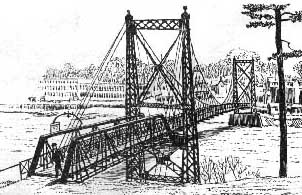 |
Kotlas - Waterville Area Sister City Connection P.O. Box 1747 Waterville, ME 04903-1747 Write to Us |
 |
 |
Kotlas - Waterville Area Sister City Connection P.O. Box 1747 Waterville, ME 04903-1747 Write to Us |
 |
|
Home > About Kotlas > History > Gulag > Mass Grave A Mass Grave in Solvychegodsk(The following is excerpted from a letter from Irina Dubrovina to Gregor Smith. Dubrovina is a co-founder of Sovest, or "Conscience", a Kotlas organization that teaches people about the Gulag and seeks compensation for its victims.) August 22, 1994 Hello, Gregor! I want to tell you more about news of Sovest. On August 13, 1994 we had the third anniversary of the discovery in Solvychegodsk, an ancient city in the Kotlas region, of an unmarked grave containing human remains. While digging the foundation trenches for building his home, an inhabitant of this city, A.M. Saburov, found 35 skeletons in the hole, just 60 centimeters [2 ft.] below the soil surface. There were no caskets nor any sign of clothing or footwear. He called the authorities to the site and the appropriate documentation was done. The man who found the bones placed them carefully into a box and put the box in a separate shed. The Public Prosecutor refused to follow up on the matter, but found that he could turn the investigation over to Sovest. I went to the site, and then took some of the bones to an expert in Petersburg. The Mayor of the city of Solvychegodsk covered my expenses. The experts concluded that the grave dated to the 1930's. We consulted with an inspector as to how to establish to whom the remains belong. We interrogated local residents as to what had been at this place in years past. It seems that in the 1930's not far from there was a church, as well as the main road by which the groups of exiles went on foot from Kotlas up the river Vycheda to the village of Kharitonovo and even farther to the village of Yarensk [over 110 mi. NE of Kotlas]. Old-timers reported that the exiles were dressed poorly and that they marched hungry in freezing weather. Many of them fell from exhaustion and died on the road. Then the authorities instructed local inhabitants to cart their bodies off the road and to throw them into common graves and cover them over. The deaths of these people weren't recorded anywhere except on the lists of those who held them prisoner, i.e. in the files of the NKVD and the police. In the Archangel archive of the Ministry of Internal Affairs there was a file on the convoy of one such group in which only 1/3 of the people made it to the place where they were assigned. On the basis of such evidence, one could conclude that in this unmarked grave which was found in Solvychegodsk, through which all these convoys passed, were the remains of exiles from the 1930's. In November of 1992 the remains were re-interred with an Orthodox service at the city cemetery, and on August 13, 1994 a monument was erected at this grave. The funds for the monument were collected by Sovest. Contributions came from citizens of the cities of Solvychegodsk and Kotlas. The man who found these remains, an inhabitant of the city of Solvychegodsk and a member of Sovest, Anatoliy Mikhailovich Saburov, himself designed the grave and its stone. The workers of the Department of Culture of the city of Solvychegodsk took on the maintenance and upkeep of this grave. <— Previous • Top • Intro • Next —> |